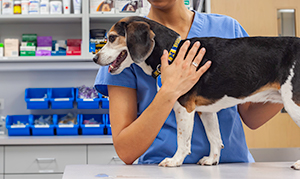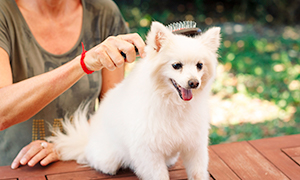Can Proteins Help Improve Skin and Coat Condition?

There are a number of ways, therefore, in which nutrition can have a possible impact on dermatology:
-
It must not result in undesirable effects through deficiencies, imbalances or allergies
-
It must contribute to improvements in the quality and appearance of the coat
-
It must assist and enhance the skin’s barrier effect providing better prevention of dermatoses and dermatitis.
Proteins are amongst those nutrients to which prime consideration should be given, since they are the main constituents of the skin and coat.
Proteins: Essential Constituents of the Skin and Coat
The cutaneous tissue (skin + sub-cutaneous tissue + coat) forms the largest organ of the body: it represents 12 to 24% of the weight of a dog1. Moreover, it undergoes an intense renewal process: the epidermis is replaced approximately every 22 days in dogs, and the annual production of hair varies (depending on the breed) between 60 and 180g per kg of weight2. These few figures show the intense level of skin and coat requirements, both in terms of their functions and of their structure.
A. Quantitative requirements
Proteins represent about 95% of the hair structure in cats and dogs. 25 to 30% of daily protein intake is systematically used solely for skin and coat renewal requirements1. Any protein deficit quickly results in obvious effects on the coat: reduction in hair diameter and in the size of the pilous bulb, hairs become brittle, pilous follicles become dormant and the skin dies. A protein deficit also affects the skin in the form of keratinisation anomalies: the skin becomes thin and less supple. Healing of wounds is adversely affected; sores and decubitus ulcers are also observed as possible consequences of protein deficiencies. Finally the protein deficit is expressed as immune incompetence and as much greater sensitivity to skin injuries and infections1.
The minimum recommended protein intake is 18% DM for an adult dog and 25% DM for an adult cat3. However the requirement becomes 25-30% DM for dogs and 30-45% DM for cats if skin and coat maintenance is of prime importance1.
B. Qualitative requirements
The quantity of protein is not the only factor to be taken into consideration, proteins must also be easily digestible and provide all the essential amino acids required by the cutaneous metabolism. A single limiting amino acid in the diet is all that is needed to disturb protein synthesis and for the dermatological signs described above to appear5.
-
Amino acids and the structure of the skin and coat
Keratin is an essential constituent of the stratum corneum of the epidermis and of hair. It is essentially composed of the sulphur-containing amino acids methionine and cysteine. Sulphur-containing amino acids are most abundant in proteins from an animal source6.
2. Amino acids and coat colour
The quality of the protein intake can affect the colour of the coat. The synthesis of melanins, which are responsible for the colour of the coat (dark eumelanins and yellow and orange pheomelanins) essentially depends upon a sufficient precursor amino acid intake. An insufficient intake of aromatic amino acids (phenylalanine and tyrosine) can adversely affect the synthesis of eumelanin: a black cat or dog can acquire areas of brown lustre and tawny colours become lighter in hue7-9.
3. Amino acids and cutaneous metabolism
Special attention must also be paid to levels of glutamine and arginine in the diet. Glutamine is the preferred energy-source substrate for rapidly regenerating cells, such as immune cells and fibroblasts10.
Arginine plays an important role in immunity regulation. It also encourages the synthesis of collagen and acts as a precursor of proline10. Finally the production of nitric acid from arginine stimulates the expression of the vascular endothelial growth factor9.
Conclusion
A high level of animal protein in the diet ensures a high intake of sulphur-containing amino acids, essential for proper regeneration of the cells of the skin and of the coat. A high protein intake also helps to reduce the risk of any possible deficit of tyrosine and of amino acids which are necessary for the synthesis of melanin coat pigments.
References
1. Roudebush P, Schoenherr WD. Skin and hair disorders. In: Small Animal Clinical Nutrition 2010; 637-643.
2. Delaunay O. Role of diet in the development or improvement of dermatoses in dogs. Thèse de Doctorat Vétérinaire, Alfort, 2012.
3. FEDIAF. Nutritional Guidelines for complete and complementary pet foods for cats and dogs 2014; 16-21.
4. Analyse concurrentielle des aliments diététiques «dermatologie » secs pour chiens et chats distribués en circuit vétérinaire. Données internes 2013.
5. Steiff EL, Bauer JE. Nutritional adequacy of diets formulated for companion animals. J Am Vet Med Assoc 2001; 219: 601-604.
6. Analyse comparative du profil en acides aminés de différentes sources alimentaires utilisées dans l’alimentation industrielle du chien et du chat. Données internes 2013.
7. Anderson PJB et al. Cats require more dietary phenylalanine or tyrosine for melanin deposition in hair than for maximal growth. J Nutr 2002; 132: 2037-2042.
8. Yu S et al. Effect of low levels of dietary tyrosine on the hair colour of cats. J Small Anim Pract 2001; 42: 176-180.
9. Prélaud P, Harvey R. Nutritional dermatoses and the contribution of dietetics in dermatology. In: Encyclopedia of Canine Clinical Nutrition 2006; 60-85.
10. Mann G. Nutrition et cicatrisation. In: cicatrisation.info: le livre 2006 (www.cicatrisation.info).

